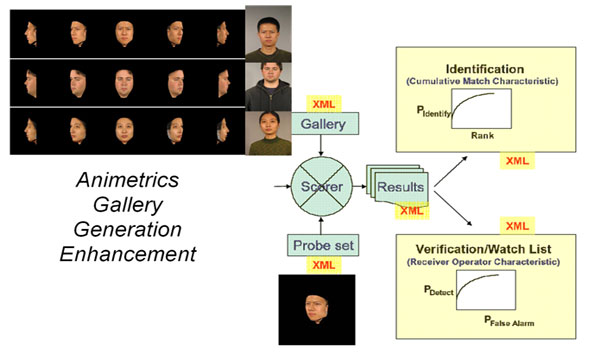2D-3D FACEngine® Face Recognition Performance Based on Gallery Generation.
Market leaders for facial search will emerge based on the technology which is most robust, providing highest accuracy in performance and serving the convergence of access control, ID management and surveillance. Animetrics has the distinct advantage in facial biometrics against the competitors by leading in performance with 3D core technology inside and leading in accuracy with proprietary FACEngine® search algorithms. This competitive advantage allows us to integrate the control environments (studio quality photography) with those of the more natural environments of the consumer.
The Animetrics 2D-3D FACEngine® technology was first introduced in 2005 in controlled government tests, and have now been tested by the Army at Aberdeen proving grounds in 2006, 2007, and 2008. To compare directly to leading vendors technology, examine the 2005 Unisys report on the first results from an independent government validation of the Animetrics 2D-3D FACEngine® core technologies. The independent evaluation was conducted by Unisys for the Department of Defense and published 2005. The study was part of a large government test examining the most outstanding 3D technologies available in the world. Animetrics was selected as a preprocessing technology for generating 3D avatars from which corrected normalized libraries were generated for both access control and surveillance for the 2D FR system.
Depicted in the figure is the gallery enhancement method used for enrolling each individual into the Identix system. Notice the probe is spawned into 5 different views using the Animetrics 2D-3D model technology. This enhances the power of the Identix face recognition system.

Depicted in the Figure below is the experimental setup (left panel) depicting off frontal and off pose positioning of the cameras. Under all conditions, both front view and non-cooperative surveillance Animetrics technologies greatly enhanced state-of-the-art FR systems by decreasing by as much as a factor of ten false acceptance rates.
At the off-angle captures by Camera 2, we see that 3D model view-based surveillance clearly improves the performance over single still frontal databases. For the on-angle captures of Camera 1, the frontal baseline database performs obviously much better. However, 3D model view based databases still provide a performance boost.
Depicted in the Figure (right panel) is the face recognition performance achievable with Animetrics90 2D-3D FACEngine® technologies compared to that of the Identix conventional FR system from the 2005 Unisys test. The red curve shows a 95% verification rate at the false accept rate (FAR) of 0.1% for the Animetric90 2D-3D FACEngine® enabled technology. The performance enhancement associated with 2D-3D FACEngine® technology demonstrates a near factor of 10 decrease in FAR for the Identix system (red curve) without 2D-3D FACEngine® enhancement (black curve).

Patents
- U.S. Patent number 7,643,685: Viewpoint -Invariant Image Matching and Generation of Three-Dimensional Models from Two-Dimensional Imagery.
- U.S. Patent number 7,643,683: Generating Image Data Bases for Multifeatured Objects.
- U.S. Patent number 7,643,671, Facial Recognition System and Method.
- U.S. Patent number 7,853,085. Viewpoint Invariant Detection and Identification of 3D Object from 2D Imagery.
- U.S. Patent number 2007/0080967A1, Publication Date April 12, 2007: Generation of Normalized 2D Imagery and ID Systems via 2D to 3D Lifting of Multifeatured Objects. Pending.
